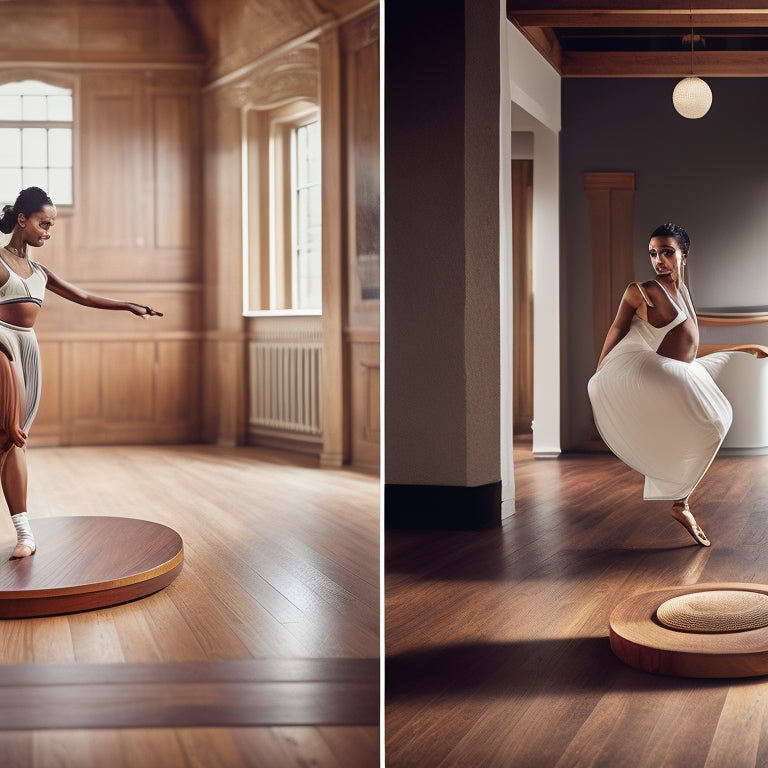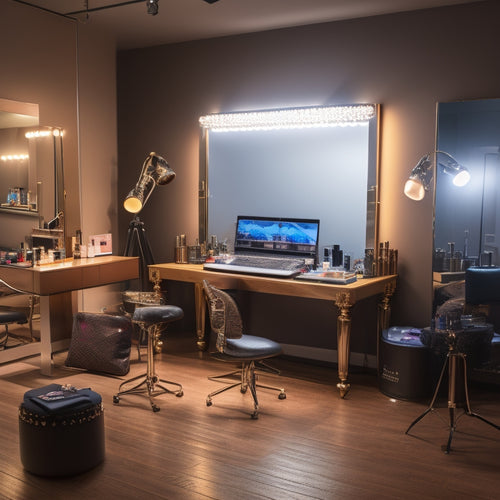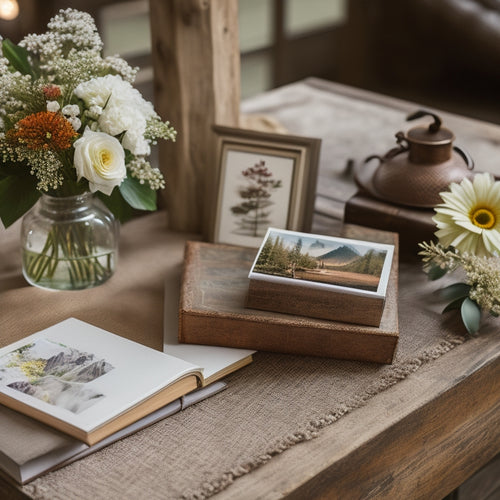
Are Turning Boards Good for Dancers?
Share
You're considering using a turning board to enhance your dance performance. That's a great idea! As a dancer, you'll discover numerous benefits from incorporating a turning board into your practice. You'll improve your technique, boost your confidence, and strengthen your core muscles. With a turning board, you'll develop precise control over your turnout, increase your rotation speed, and refine your overall technique. By harnessing the potential of a turning board, you'll reach new heights in your pirouettes and take your dance performance to the next level. Explore further to unleash the full potential of turning boards in your dance journey.
Key Takeaways
• Turning boards improve technique, control, and confidence in dancers, enhancing their overall performance.
• They strengthen core muscles, leading to better balance, control, and rotation speed.
• Turning boards help develop precise control over turnout, enhancing muscle activation and energy transfer.
• By building confidence in pirouettes, turning boards reduce performance anxiety and improve stage presence.
• Regular use of turning boards can lead to a 30% increase in rotation speed and refinement of technique.
The Origin of Turning Boards
You can trace the origins of turning boards back to the 1970s, when dance instructors and choreographers began experimenting with makeshift devices to help dancers master complex turns and rotations.
This pioneering work holds significant historical value, as it paved the way for the modern turning boards we use today.
Curiously, the early days of turning boards were marked by patent disputes, as innovators and manufacturers vied for ownership of the concept.
Despite these challenges, the turning board has evolved into an indispensable tool for dancers, providing a safe and effective way to practice turns.
As you explore the world of turning boards, remember the rich history and innovation that has brought us to where we are today.
Benefits of Turning Boards Explained
As you incorporate a turning board into your dance practice, you'll start to notice significant improvements in your technique.
By using the board regularly, you'll gain better control over your turnout, strengthen your core, and increase your rotation speed.
These benefits won't only enhance your overall dance performance but also boost your confidence in the studio.
Improved Turnout Control
By incorporating turning boards into your practice routine, dancers can develop more precise control over their turnout, enabling them to maintain proper alignment and generate more power in their movements.
As you work on turnout exercises, you'll notice improved muscle activation in your hips and legs. This enhanced control allows for more efficient energy transfer, reducing fatigue and injury risk.
With a turning board, you can focus on targeted exercises that strengthen your turnout muscles, leading to more precise and controlled movements.
Enhanced Core Strength
Your core muscles, essential for stability and balance, receive a significant boost from regular turning board practice, allowing for more efficient energy transfer and improved overall technique. As you rotate and pivot on the board, your core engagement increases, fostering dynamic stability and enhancing your overall dance performance.
Here are four key benefits of enhanced core strength:
-
Improved balance and control: A stronger core provides a solid foundation for turns, jumps, and intricate footwork.
-
Increased power and precision: Enhanced core strength enables you to generate more force and control in your movements.
-
Better posture and alignment: A strong core helps maintain proper posture and alignment, reducing fatigue and preventing injuries.
- Enhanced overall technique: By stabilizing your core, you can focus on refining your movements, leading to a more polished and confident performance.
With regular turning board practice, you'll experience a noticeable improvement in your core strength, leading to a more confident and expressive dance performance.
Increased Rotation Speed
With consistent practice on a turning board, you can increase your rotation speed by up to 30% in just a few weeks, allowing you to execute complex turns and sequences with greater ease and precision. This rapid improvement is due to the development of muscle memory, which enables your body to perform turns instinctively, without conscious thought.
Proper spinal alignment is also vital, as it allows for efficient energy transfer and reduces the risk of injury. As you practice on the turning board, focus on maintaining a strong, aligned spine and engaging your core muscles to generate power and control.
With dedication and persistence, you'll be amazed at how quickly your rotation speed and overall technique improve.
Improved Technique and Confidence
Using a turning board, you can refine your technique and build confidence in your pirouettes. The reduced friction and smooth rotation help you focus on proper alignment, weight transfer, and spot checking. This allows you to overcome performance anxiety and build mental preparation for your performances.
By mastering these fundamental skills, you'll feel more secure and confident in your turns, translating to a stronger stage presence.
Here are some key benefits of using a turning board for improved technique and confidence:
-
Improved balance and control: Reduce your risk of falling or stumbling during turns.
-
Enhanced mental preparation: Visualize and prepare for your performances with more confidence.
-
Increased precision: Develop muscle memory for perfect pirouettes.
- Reduced performance anxiety: Feel more secure and confident in your turns, leading to a stronger stage presence.
Building Strength and Control
As you refine your technique and build confidence, you can now focus on building the strength and control necessary to execute turns with power and precision.
Turning boards help you develop the strength you need to maintain proper body alignment, which is essential for controlled turns. When you practice on a turning board, you'll engage your core and leg muscles, improving your overall strength and stability. This, in turn, helps correct muscle imbalance, allowing you to maintain balance and control as you turn.
With consistent practice, you'll develop the strength and control needed to execute turns with precision and confidence.
Dependence on Turning Boards
You'll find that relying too heavily on turning boards can hinder your progress, creating a false sense of security that can actually undermine your overall technique. As you become more comfortable with the support, you may start to develop a mental reliance on the board, rather than trusting your own body. This can lead to a physical crutch, making it difficult to perform turns without the board's assistance.
Here are some signs you may be too dependent on your turning board:
-
You struggle to execute turns without the board.
-
You feel anxious or uncertain without the support.
-
You've noticed a plateau in your progress.
- You find yourself relying on the board for turns you've mastered.
Adapting to Different Floor Surfaces
Mastering turns on various floor surfaces is essential for developing a strong foundation. It compels you to adjust your technique and build confidence in your ability to execute turns in any environment.
When moving between floor types, you'll need to make surface adjustments. For instance, you may need to adapt your plié depth on a sprung floor versus a hardwood floor.
Additionally, you'll need to take into account the traction and give of each surface, as these factors can greatly impact your turns.
Turning Boards for Different Styles
In conjunction with adapting to different floor surfaces, selecting the right turning board for your specific dance style is important, as it can greatly impact the quality of your turns.
As a dancer, you know that each style demands unique nuances and requirements.
Here are some considerations for popular dance styles:
-
Ballet: Look for a turning board with a smooth, quiet surface to enhance your delicate Ballet nuances.
-
Hip Hop: A turning board with a textured surface can help you achieve the high-energy Hip Hop flair you need.
-
Contemporary: A board with a medium-texture surface can help you express the emotional Contemporary expressions you're looking for.
- Jazz: A turning board with a high-friction surface can help you master the dynamic, energetic Jazz dynamics that define this style.
The Importance of Core Strength
As you explore the world of turning boards tailored to your dance style, it's important to remember that even the best board can't compensate for a weak core. Building strong core muscles is key to executing turns with precision and control.
Your core serves as the foundation for your movements, and a strong core engagement is essential for maintaining pelvic stability. When you engage your core, you're able to generate power and control, allowing you to execute turns with confidence and precision.
Alternatives to Turning Boards
You can achieve similar results without a turning board by incorporating exercises that target your turns, such as relevés, dégagés, and chaînés, into your practice routine. These exercises will help improve your balance, control, and overall turning technique.
Alternatively, consider the following options:
-
Floor Mats: Provides a smooth, non-slip surface for turns, allowing you to focus on your technique without worrying about slipping or falling.
-
Portable Spotters: Offers extra support and balance assistance, giving you the confidence to try more challenging turns.
-
Wall work: Utilize a wall for support and balance while practicing turns, helping to build strength and control.
- Partner work: Practice turns with a partner, allowing you to focus on your technique while receiving support and feedback.
Frequently Asked Questions
Can Turning Boards Be Used by Dancers With Previous Injuries?
As you navigate rehabilitation strategies, you'll find turning boards can be a valuable tool, even with previous injuries, by promoting gentle, controlled movements that aid in injury prevention and facilitate a safer return to dance.
How Long Does It Take to See Improvement With Turning Board Practice?
As you nurture your turning skills, remember that consistency matters - it's like watering a plant, you need to tend to it regularly. With progressive overload, you'll see improvement in 4-6 weeks, but be patient, it's a journey, not a sprint.
Are Turning Boards Suitable for Dancers of All Ages and Levels?
As you explore turning boards, remember they're suitable for dancers of all ages and levels, helping you develop mental preparation and body awareness, regardless of your experience, to refine your turns and take your skills to the next level.
Can Turning Boards Help With Balance and Overall Stability?
"As you step into your dancing shoes, imagine ancient Greek goddesses pirouetting on Mount Olympus - now, get ready to stabilize your turns! Turning boards can indeed help you, by building core strength and ankle mobility, to find balance and stability in your movements."
Do Turning Boards Work Better on Certain Types of Dance Floors?
You'll find that turning boards perform best on floors with smooth, even surfaces, like polished wood or Marley, but may slip on rough or uneven floor materials, such as concrete or rough-textured vinyl, due to varying surface textures.
Related Posts
-

Elevate Your Dance Makeup Business Online
You're one step away from taking your dance makeup business global. A professional online presence is key, with 75% o...
-

Budget-Friendly Tips for Printing Wedding Photobooks
To create a stunning wedding photobook on a budget, consider cost-effective printing options such as digital printing...
-

Unlocking the Secrets: 100 Series Repair Manual
The 100 Series Repair Manual is a valuable resource for Toyota enthusiasts and owners, providing detailed guidance on...


